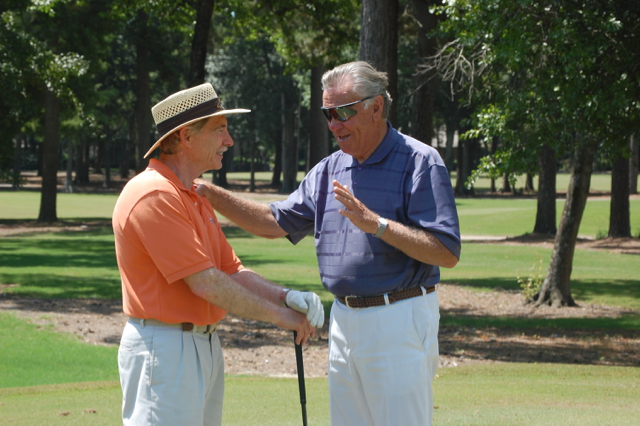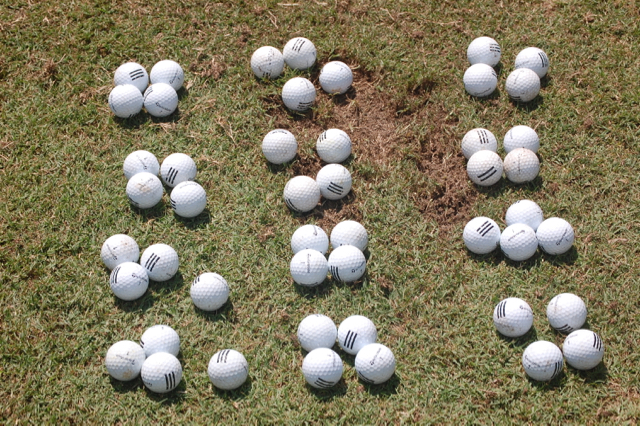An old driving range professional ruined my golf swing before it even had a chance to develop 55 years ago, when my parents sent me for a lesson at age 12. It took me the better part of the next five decades to overcome a hard pull to the left – some of you know it as a “double cross” -- that insinuates itself, seemingly at random, at the most inauspicious moments, into my swing. I blame it on that old pro who spent my 45-minute lesson reminding me to “Roll your wrists...roll your wrists...roll your wrists” through the ball.
After that experience, it would be 40 years before my next lesson, and only then because my wife, tired of hearing me complain about my inconsistent golf game, pre-paid for a lesson with Mel Sole, a former touring pro originally from South Africa who has worked with golf professionals, celebrities and committed amateurs since the 1970s. Mel’s golf school, which he runs with his wife Rosemary, anchors one end of the Pawleys Plantation practice range in Pawleys Island, SC, a few hundred yards from the vacation condo my wife and I own. At my lesson with Mel 15 years ago, he brought out a “new club innovation” for me to try, one of the first hybrids. The club felt and looked a bit weird, and I made little solid contact with it. Today, though, I rely on my 3-iron equivalent hybrid as much as I do my wedges. Mel, who is proudly old school in some ways, doesn’t shrink from such new technology; indeed, he incorporates it into his teaching. (See below) Because class size does not exceed four golfers, Mel Sole (right), who runs the golf school that bears his name, can give all his students individual attention.
Because class size does not exceed four golfers, Mel Sole (right), who runs the golf school that bears his name, can give all his students individual attention.
In May, on assignment for CarolinaLiving.com, I returned to the Mel Sole Golf School for three half days of lessons. My fellow students were a married couple from New Jersey. Larry had attended a couple of Mel’s golf schools in the past; Mary was a total beginner.
As mentioned above, for a guy who will celebrate his 50-year anniversary as a golf professional in 2016, Mel is no Luddite when it comes to new technology. He used videotape as soon as it became available in order to capture his students’ swings and then compare them, side by side, to the swings of some of the most famous
In my case, the video and Mel’s commentary identified three distinct flaws in my golf swing. First, my chin was firmly planted on my sternum at address, which restricts shoulder turn. Second, my takeaway was on an inside path, which promotes a pull of the ball to the
Once he identified the flaws in our swings, Mel put his three students through the 48-Ball Drill which, to some, may seem like a bit of pop psychology but, in reality, seems like the only way to drill (pardon the pun) the lessons into your swing. The 48 balls are 12 clusters of four balls each. Once you choose a club from your bag – Mel doesn’t require one or the other club since the lesson is all about the swing – you go through the “Drill” phase with the first cluster of balls. In my case, I raised my chin off my chest, then I slowly took the club back along a straight path and stopped it at the top; then I exaggerated my hip slide as the first step toward bringing the club down (in other words, my hip, not my arms, started the club on its path downward). As the club descended, I could not help but rotate my hips and turn my shoulder. Mel insists on two practice swings before an attempt at striking a golf ball. It is awkward to hit a golf ball from a stopped position at the top of your backswing, but I definitely could feel those hips sliding and understood their effect on the downswing. I made the start and stop swing for each of the remaining three balls in the cluster (after, of course, the required two practice swings for each ball).
 Mel Sole's 48 ball drill is a disciplined approach to learning in which stopping and restarting your new, improved golf swing midway through plays a pivotal part (in one student's case, literally so, since I was learning to slide and pivot my hips through the ball).
Mel Sole's 48 ball drill is a disciplined approach to learning in which stopping and restarting your new, improved golf swing midway through plays a pivotal part (in one student's case, literally so, since I was learning to slide and pivot my hips through the ball).The next cluster of balls was for the “Continuous” swing which is exactly as the term implies. I made sure on my two practice swings to get my chin away from my sternum, to take the club back on a straighter path, and then focused on starting the downswing with the hip slide. It was a work in progress. Concentrating on that hip slide caused me not to rotate my hips naturally, and I found myself shaving the ball off to the right. But as the practice session progressed, and I relaxed a bit, the ball began to fly on a straighter path. The final cluster of balls is for what Mel calls the “Clear Key,’ an exercise to clear the mind and avoid thinking about the swing changes you are working on. For the “Clear Key,” you choose a word or short phrase to say to yourself as you make the entire swing. Mel himself uses the word “Geronimo”; I chose “Shakespeare” with a nod to my English Lit degree. The Clear Key is essentially the Continuous swing but with the Clear Key word or phrase distracting you from any conscious thought about what you are working on, the hope being that the Drill and Continuous activities have worked their magic. For the final three clusters of balls, I chose a different club for each group and repeated the process.
End of Part 1; Part 2 posts on Friday



